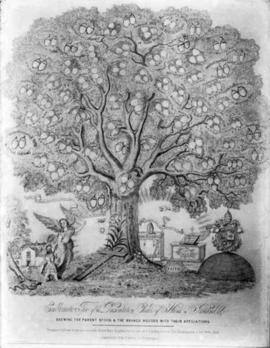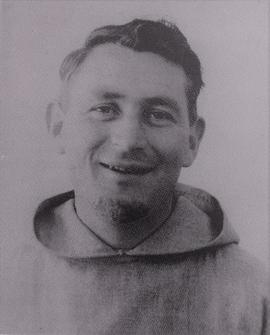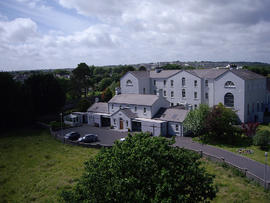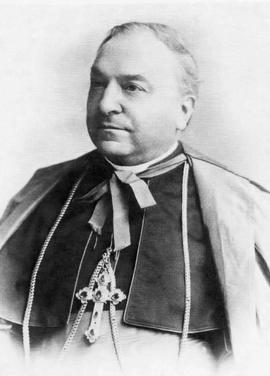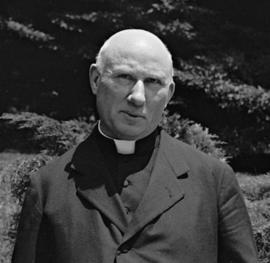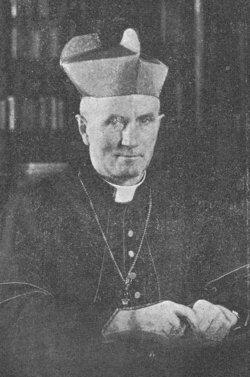The Presentation Brothers are an international, Catholic congregation of religious brothers, founded in 1802 by Blessed Edmund Rice in Waterford, Ireland. The expressed mission of the Presentation Brothers is to "form Christ in the Young" and traditionally they have worked to achieve this through education.
Edmund Rice was born in the townland of Westcourt near the village of Callan in County Kilkenny on 1 June 1762. His parents, Robert Rice and Margaret Tierney Murphy, were prosperous farmers. At the age of 17, Rice was apprenticed to his uncle, Michael Rice, in Waterford city. Several years later, Edmund’s uncle signed the business over to him and Edmund began to invest his growing fortune in land and property. At the age of 25, Edmund married Mary Elliott but, sadly, Mary died in January 1789 following a horse-riding accident. Edmund and Mary had a daughter who was also called Mary.
After his wife’s death, Rice became more religious and he developed a devotion to St. Teresa of Avila. He also became involved in charitable works and regularly visited the poor of Waterford providing financial assistance to those in need. In 1798, Edmund helped the Presentation Sisters open a convent and school for girls in Waterford. Rice decided to try something similar for young boys, and in 1800 he began to teach youngsters at his business premises in Barronstrand Street with the assistance of some volunteers. The following year, Rice converted some stables on New Street into a makeshift school. His friends and colleagues described it as an act of "mad folly". Two men, Patrick Grosvenor and Patrick Finn, arrived to help. The three men lived above the school where they prayed together and shared their possessions. This school would go on to be known as Mount Sion Primary School which exists to this day.
Between 1802, when he opened his first school and 1808, Rice gathered around him a group of companions to help him in his work. These first Brothers took their vows on 15th August 1808 in the chapel of the Presentation Convent, Waterford, and together they became known as the Society of the Presentation. They lived their religious life based on the Rule of the Presentation Sisters (founded by the Venerable Nano Nagle in 1775), adapted for men. The Presentation Rule defined the new institute as a diocesan institute. This meant that, initially in Waterford, and later on in other dioceses where the Brothers worked, the local Bishop was their Superior. Unlike institutes of pontifical rite, the new religious institute had no Superior General of its own.
As the work of Edmund Rice expanded to Dublin, Cork and other Irish cities and towns, a need for central planning and direction emerged in the developing educational mission of the Brothers. From 1817 onwards, Edmund Rice began to consider adopting a constitution along the lines of that used by the Brothers of the Christian Schools in France. The De La Salle Brothers were an institute of pontifical rite, and had their own Superior General and elected administration. They were, to a great extent, independent of local bishops and this gave them great freedom in the development and expansion of their work. Rice felt that the Presentation Rule had served the group well in its early years, but Rome would only grant his group pontifical status if they adopted a pontifical rule already in existence. He decided to propose to his Brothers that the group should adopt a new De La Salle style rule. Controversy and debate ensued over a number of years and ultimately led to a division within the group. The vast majority of the Brothers ultimately accepted the adoption of a rule along the lines of that used by the Brothers of the Christian Schools in France. A minority of two continued to live the Presentation Rule and remained under the jurisdiction of their local bishops. The majority, known as the Christian Brothers since 1822, elected Edmund Rice as their first Superior General. The group experienced considerable expansion and development during the following decades.
Of the two Brothers who chose to remain with the Presentation Rule, Brother John Ignatius Mulcahy taught at a school in Cappoquin, County Waterford until his death in 1845. He was not joined by any followers. The second Brother, Michael Augustine Riordan of Cork, was joined by a number of followers and continued to follow the Presentation rule.
Brother Michael Augustine Riordan had entered the North Monastery in Cork in 1814 (there had been a community of Brothers in Cork since 1811; Brother Jerome O'Connor and Brother John Baptist Leonard founded the Peacock Lane Monastery, also known as the North Presentation Monastery, and were given charge of the Cork Charitable Society’s North School off Chapel Lane by the Bishop of Cork, Dr Francis Moylan). There had been considerable division in the North Monastery concerning the acceptance of the new rule over a number of years. An architect by profession, Riordan had helped in the building of many Cork churches before his entrance to the Brothers. His personal sense of loyalty to the then Bishop of Cork, John Murphy, greatly influenced his decision to remain with the Presentation Rule. In 1827, with the support of Bishop Murphy, he left the North Monastery and was given a house in Douglas Street, on the south side of the city. This became known as the South Monastery and Brother Riordan was joined there by some companions who lived as Presentation Brothers under the jurisdiction of the Bishop of Cork.
The Brothers began to conduct two schools in the city, one in the South Monastery itself, another a Lancasterian School on Great George's Street, today known as Washington Street. Thus, Brother Riordan played a pivotal role in the survival of the Institute of Presentation Brothers who would continue to live the original rule chosen by Edmund Rice and his early companions.
The Presentation Brothers continued their work in the Cork schools and expanded to Kerry in 1838. A foundation was made in Deptford, England in 1876 and in Birr, Co. Offaly, in 1879. By the 1870s however, a new younger group of Brothers began to address the issue of diocesan versus central control. As various types of schools were founded in diverse places, it became obvious that the Presentation Congregation should develop from its present diocesan status to being an institute of pontifical rite. In 1874, the Bishops of Cork and Kerry, on behalf of the Brothers, requested Rome to grant pontifical approval to the Presentation Institute. A Decree was received from Rome in the same year granting temporary approvaI. In 1885, the Presentation Brothers submitted a petition to Rome requesting its approval for a central government for the Presentation Institute under its own Superior General. By 1889, Rome granted temporary approval and final approbation came ten years later in 1899.
Throughout these developments, the Brothers retained the original Presentation Rule. Changes were inserted however to allow for a central government under a superior general and council. The first formal general chapter of the Brothers of the Presentation Institute was held in the South Monastery Cork in July 1889. Brother Patrick Shine was elected superior general and with him four assistants to help in the government of the Congregation.
The number of communities and schools established and managed by the Presentation Brothers greatly increased in the subsequent decades, both in Ireland (including Cork, Cobh, Kinsale, Bray, Dungannon, Enniskillen, Carrick-on-Shannon, Boyle, Letterkenny) and overseas (including Canada, USA, Ghana, Nigeria, Barbados, Grenada, St Lucia, Trinidad and Tobago, Peru, and Slovakia).
The Presentation Brothers have a presence in a number of these locations to the present day, and continue to work in the area of education as well as a wider range of ministries including with the homeless, elderly, disadvantaged youth and the Roma people.
Much of this history of the Presentation Brothers was sourced from 'The Contribution of the Presentation Brothers to Irish Education 1960-1998: A Study of a Roman Catholic Religious Teaching Institute in a Time of Change and Transition', a PhD thesis written and submitted to the University of Hull by Br Michael Martin Kenneally.
Thomas Joseph Prendiville was born in Ballymacelligott in County Kerry on 27 November 1924. His early education was in the local national school and later at the Capuchin College in Rochestown, County Cork. He joined the Capuchin Franciscans in October 1944 and took Bartholomew as his religious name. He obtained a BA degree in philosophy from University College Cork in 1948. He completed his theological studies in Ard Mhuire Friary in County Donegal and was ordained to the priesthood on 12 June 1952. He returned to St. Bonaventure’s Friary in Cork and obtained a Higher Diploma in Education (UCC) before travelling to Norther Rhodesia (now Zambia) for missionary work in 1953. He spent eighteen years in Zambia. In 1971 he was transferred to the Cape Town mission in South Africa. His years in Zambia mainly involved work in the education sector, first as a manager of schools at several mission stations, and later as education secretary in Livingstone. In South Africa, he served as parish priest in several churches in various Cape Town suburbs including Langa, Belgravia and Parow. He served as consultor to the Regular Superior of the Cape Town mission on two occasions (1971-4; 1974-7). He was elected Regular Superior in 1977 and held this position until 1983. He died in Parow, Cape Town, on 7 July 2004 and was buried in Maitland Cemetery.
Baptismal name: Thomas Joseph Prendiville
Religious name: Fr. Bartholomew Prendiville OFM Cap.
Date of birth: 27 Nov. 1924
Place of birth: Ballymacelligott, County Kerry
Name of father: Michael Prendiville
Name of mother: Hanora Prendiville (née Scanlon)
Date of reception into the Capuchin Order: 3 Oct. 1944
Date of first profession: 4 Oct. 1945
Date of final profession: 4 Oct. 1948
Date of ordination (as priest): 12 June 1952
Educational attainments: BA (1948); Higher Diploma in Education (1953)
Missionary activities: Travelled to Livingstone, Northern Rhodesia (later Zambia) on 26 Aug. 1953. He was transferred to Cape Town, South Africa, on 12 May 1971.
Leadership positions: Regular Superior, Cape Town Mission, South Africa, 1977-83
Date of death: 7 July 2004
Place of death: Parrow, Cape Town, South Africa
Place of burial: Maitland Cemetery, Cape Town, South Africa
In the early 17th century, as a result of continued persecution of Catholics, it was illegal for women to train in Ireland as religious so many opted to travel to Spanish Flanders, France or Spain in order to fulfill their calling. This was the case with the foremothers of our community. They travelled to the Poor Clare monastery in Gravelines, then in the territory of Spanish Flanders, modern-day Northern France. Some of them had brothers who were already Franciscans in the Irish Franciscan College in Louvain. That college had been founded in 1607.
The Poor Clare monastery of Gravelines was founded in 1609 to provide a house for English women who wished to become Poor Clares.As the Irish friars were already established in Louvain they provided spiritual assistance to this monastery before their Irish sisters arrived. Our foremothers joined this community in the early 1620s and by 1626, they numbered five sisters. In that same year on the 20th of May they left the Gravelines community and set out to found a separate house specifically for Irish women in the neighbouring town of Dunkirk. As circumstances changed they eventually decided to return to Ireland in 1629 now numbering seven. After a short period in Dublin they eventually settled in a rural part of Co. Westmeath not far from Athlone. The monastery was appropriately called 'Bethlehem' to emphasise the central focus of Franciscan spirituality, namely the poverty and humility of the Son of God in taking on our human flesh and becoming one with us in the Incarnation.
As the number of women joining the community grew daughter houses were established in Galway, Drogheda, Athlone and Wexford.
We thank God for the life and witness of our sisters and for their faith, courage and dedication to Christ and His holy Mother after the example of St. Francis and St. Clare. We pray that whatever our state in life, we may be faithful to God as they were and that our lives may bear great fruit as theirs did.
This year, 2022, marks the 400th anniversary of the solemn profession of blood sisters Cecily and Eleanor Dillon on the 8th of September 1622. . Sr. Cecily was the Abbess of Bethlehem monastery, the motherhouse of our Galway monastery at the time that the foundation was made in 1642.
In the retreat of our Province dedicated to him, the festival of St Paul of the Cross has been, in two successive years, marked by a death of a son who had served his Congregation through many and devoted years. Last year Father Gregory of St Joseph, this year Father Pius of the Holy Ghost was called to his reward, at Mount Argus, on the Saints Festival.
Father Pius of the Holy Ghost - in the world James Devine - was at Aclare, Co. Sligo, on the festival of the Epiphany, 1838. He made his classical studies at the seminary of his native diocese, Achonry, and then went to Maynooth where, after four years study, he received Minor Orders. But it pleased Almighty God to bestow upon him the grace of a vocation to the religious life; and soon two things turned his thoughts to the Congregation of the Passion, one was a retreat given at Maynooth by Father Vincent Grotti, the founder of Mount Argus, and the other the chance perusal of the life of Father Paul Mary Packenham, its first Rector, who had died soon after the arduous labours of a mission given by us in Rathmines Parish Church. Father Pius entered the Novitiate in the autumn of 1858 and was professed on September 29th of the following year. In 1861 he was ordained priest at St Joseph's, Highgate; and immediately commenced that career of Professor of Theology which he was to pursue so successfully through many years. When, in November, 1867 all the students of the Province were gathered in Dublin, under the presidency of Father Ignatius Paoli, afterwards Archbishop of Bucharest, Father Pius was truly his "right hand," and a guiding spirit in raising our ecclesiastical studies to a very high level. This purpose he was able still more to further by his directorship of the Retreat from 1869 to 1872. During his term of office he was sent as the Visitor - General to our houses in the United States, a high responsibility, successfully discharged. As Rector of Mount Argus, he had felt keenly the inadequacy of the brick chapel first erected, though the old family mansion had been adapted to form one structure with it, and now he generously volunteered to cross again the Atlantic to raise funds for the erection of a suitable church. For this he lectured in many cities of the United States, and afterwards begged in Chile, and, crossing the Andes on a mule by the old Pioneer Road to lessen expense, also in the Argentine Republic. On his return home, he was elected, in 1875, Rector of Holy Cross, Belfast, where he commenced the building of the present monastery. At the close of this term of office, he returned to the work most congenial to him, teaching, which, interspersed with missions, and retreats to religious communities, engaged his gifted and active spirit as long as health remained. For it pleased Divine Providence to lay upon him during the last 10 years of his life a trial most heavy, because the crucifixion of his strongest characteristic, the cross of inactivity. Stealthily but surely gout seized upon his strong frame with relentless grip, crippling him so that he could no longer say Mass, and painfully affecting his memory. To his nature, inactivity and helplessness were bitter indeed, and through these years many hours silent and lonely shrunk but did not quell his cheerful spirit. These were the crown of his work, and the purifying of his love for God; in him "patients" had "it's perfect work." The end came without pain, and was in perfect peace. He had received the last sacraments on April 26th, festival of Our Lady of Good Counsel, and on the 29th, comforted by the presence of his brother, Father Arthur, and in full possession of his senses, he calmly resigned his soul to his Maker.
Father Pius's gifts were great and many, and had received from earliest years effective training. His knowledge of the classics was that of the old school, delighting to fit occasion with apt quotation. He spoke several modern languages: in Gaelic he was a foremost scholar and authority, it was the tongue of his childhood and that in which his last earthly prayers were breathed to God. In the sacred sciences he had the large and accurate knowledge that comes with years of teaching. His outlook on all things was broad; on all men was kindly. To his ready pen we owe several works of great interest, notably the "Life of Father Ignatius Spencer," "Eutropia," or instructions for converts, and the "Life of St Paul of the Cross." He had been present in the great basilica at the canonisation of St Paul not as a spectator, but with the assistant clergy as a torch - bearer, and his description not only is of a thing seen in the glow of faith, but rises to a high order of literary excellence.
His early years in the Congregation were spent with the first fathers of our Province, men who had much and hard work to do and who, as true leaders, did it thoughtless of themselves, and reliant upon God: he had their spirit: his going is the breaking of a link with the past: a past that cannot altogether fade from our vision, for their memories are happily with us, while themselves and their reward are with God.(CROSS, Vol. III, p.77f.)
Pietro Gasparri, GCTE (5 May 1852 – 18 November 1934) was a Roman Catholic cardinal, diplomat and politician in the Roman Curia and the signatory of the Lateran Pacts. He served also as Cardinal Secretary of State under Popes Benedict XV and Pope Pius XI. - Wikipedia https://en.wikipedia.org/wiki/Pietro_Gasparri
Pietro Fumasoni Biondi (4 September 1872 – 12 July 1960) was an Italian Cardinal of the Roman Catholic Church who served as Prefect of the Sacred Congregation for the Propagation of the Faith in the Roman Curia from 1933 until his death, and was elevated to the cardinalate in 1933.
Fumasoni Biondi was born in Rome to the aristocratic Filippo and Gertrude (née Roselli) Fumasoni Biondi; he had a sister who entered the Missionary Sisters of the Sacred Heart of Jesus and became known as Mother Gertrude.[1] After studying at the Pontifical Roman Seminary, he was ordained to the priesthood by Cardinal Lucido Parocchi on 17 April 1897. From 1897 to 1916, he was a professor at the Pontifical Urbaniana University and then an official of the Sacred Congregation for the Propagation of the Faith.
On 14 November 1916, Biondi was appointed Apostolic Delegate to the East Indies[2] and Titular Archbishop of Dioclea. He received his episcopal consecration on the following 10 December from Cardinal Domenico Serafini, OSB, with Bishops Joseph Legrand, CSC, and Agostino Zampini, OSA, serving as co-consecrators, in the chapel of the Urbaniana University. In this post, he actively tried to improve relations between the Vatican and the Emperor of Japan.[3] Biondi was later named Apostolic Delegate to Japan on 6 December 1919, Secretary of the Congregation for the Propagation of the Faith on 14 June 1921 and Apostolic Delegate to the United States on 14 December 1922. In 1927, he declared the Vatican had no interest in the presidential campaign of Al Smith, the Catholic governor of New York.[1]
Pope Pius XI created him Cardinal-Priest of Santa Croce in Gerusalemme in the consistory of 13 March 1933, in advance for his appointment as Prefect of the Sacred Congregation for the Propagation of the Faith three days later, on 16 March. Cardinal Fumasoni Bondi served as papal legate to the National Eucharistic Congress in Teramo on 20 August 1935. He was one of the cardinal electors who participated in the 1939 papal conclave, and again in the conclave of 1958.
Biondi died in Rome, at age 87. He is buried in the Campo Verano.
Nicholas Phelan was born in Graiguenamanagh, a small town on the border between Counties Carlow and Kilkenny, on 16 June 1874. He joined the Capuchins at the age of sixteen, took Benedict as his religious name, and was professed in 1891. He was ordained a priest in Holy Trinity church in Cork in January 1899. Following his ordination, he was appointed Master of Novices and spent five years ministering in Cork. In 1904 he was transferred to the Capuchin Friary on Church Street in Dublin. He worked in the capital for the next forty years and was the principal organiser of the choir in St. Mary of the Angels on Church Street for most of this time. He served as Provincial Secretary from 1910 to 1913. He was appointed vicar in 1919 and was guardian (local superior) of the Capuchin community on Church Street from 1922 to 1925. He acted as spiritual director of the Sacred Heart Sodality for many years and was also director of the local Third Order of St. Francis confraternity. He was well-known as a mission and retreat giver throughout Ireland but particularly in almost all the parishes in County Dublin. At the time of his death (on 19 July 1947) he was a member of the Capuchin community in Kilkenny. He died in a nursing home at 7 Mount Street Crescent in Dublin following a long period of illness and was buried in Glasnevin cemetery in the city.
Baptismal name: Nicholas Phelan
Name in religion: Benedict
Date of birth: 16 June 1874
Place of birth: Graiguenamanagh, County Kilkenny (Diocese of Kildare of Leighlin)
Name of father: John Phelan
Name of mother: Mary Phelan
Date of reception into the Capuchin Order: 23 June 1890
Date of first profession: 15 Aug. 1891
Date of final profession: 11 Oct. 1896
Date of ordination: 8 Jan. 1899
Date of death: 19 July 1947
Place of death: Dublin
Place of burial: Glasnevin Cemetery, Dublin
Two page biography to be found at: Page 1 Page 2
Full biographies include:
-After Night the Dawn : the life of Paul Mary Pakenham, Passionist by Stephen M Hanford
Born at Grange, Fedamore, Co. Limerick, he was educated at St Munchin's College, Limerick and St Patrick's College Maynooth. Ordained priest in June 1915, he returned to Maynooth to prepare for a Doctorate in Divinity. He was appointed to the staff of Maynooth, and held the post of Professor of Moral Theology before becoming Vice-President of the College in 1936. He became PP Bruff and St Munchin's before he was appointed bishop in December 1945. He was consecrated bishop of Limerick on February 24th 1946.
Bishop O'Neill prepared the ground for the development of St Munchin's College and moved the Bishop's residence to Kilmoyle. Despite being a shy person, he was the driving force behind a great deal of Diocesan work. He died suddenly in Kilmoyle on March 26th 1958 and is buried in the priests' plot in Mount St Laurence Cemetery.
https://limerickdioceseheritage.org/Diocese/FormerBishops/PatrickONeil.htm
